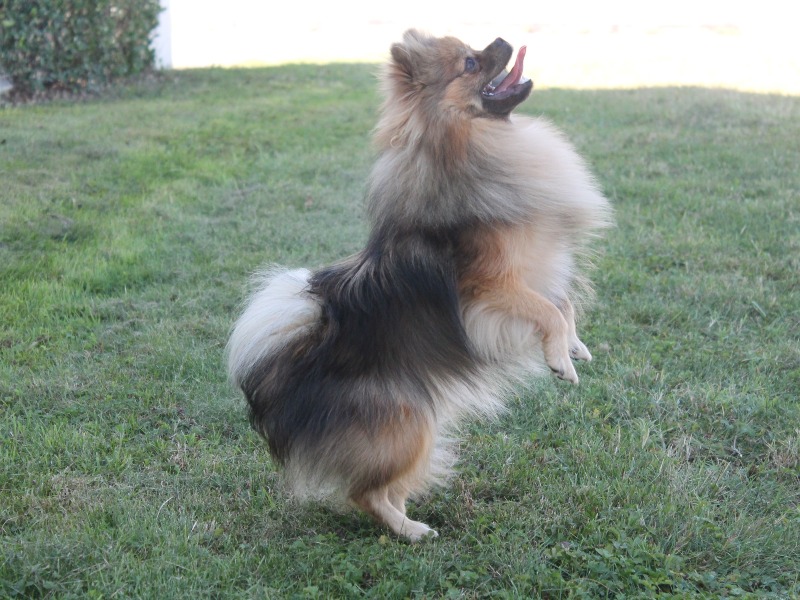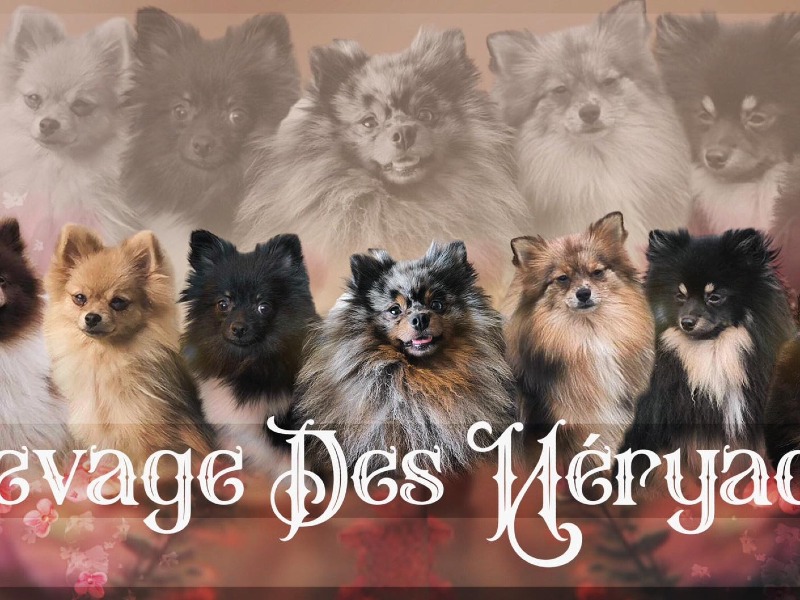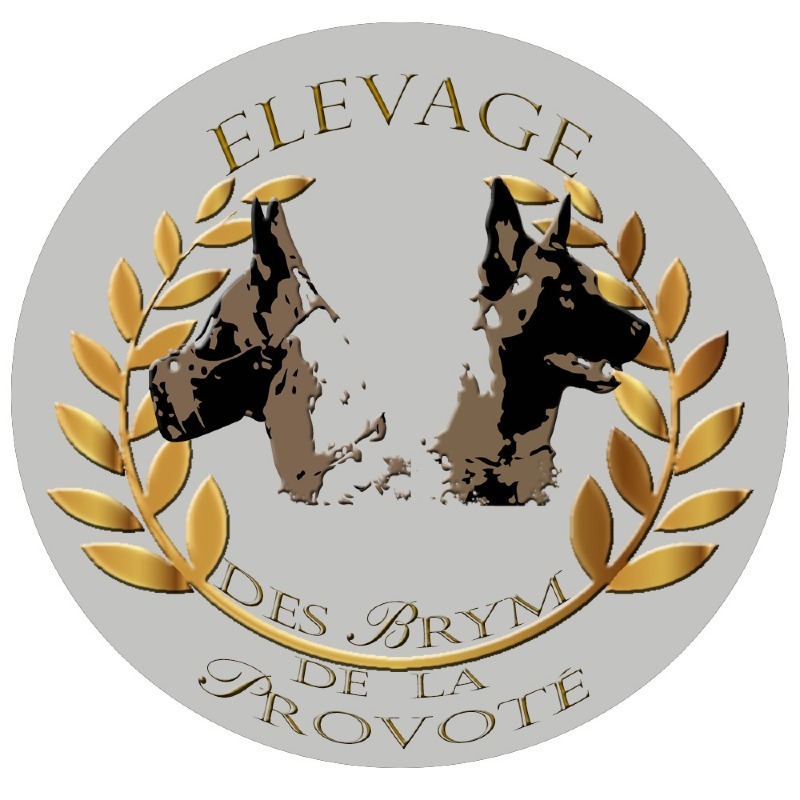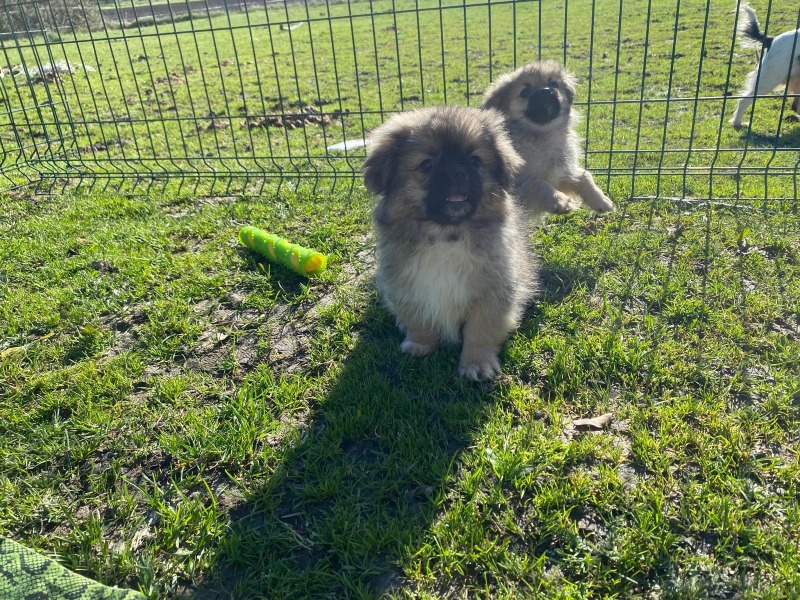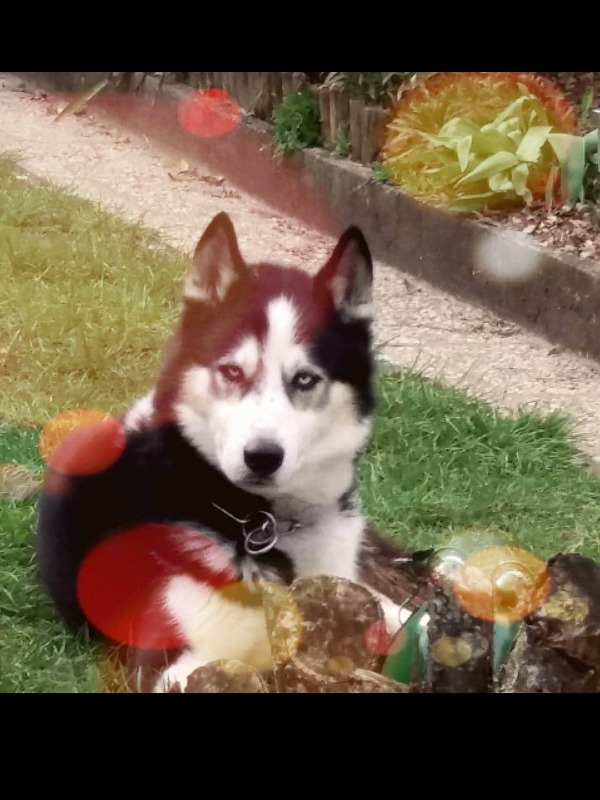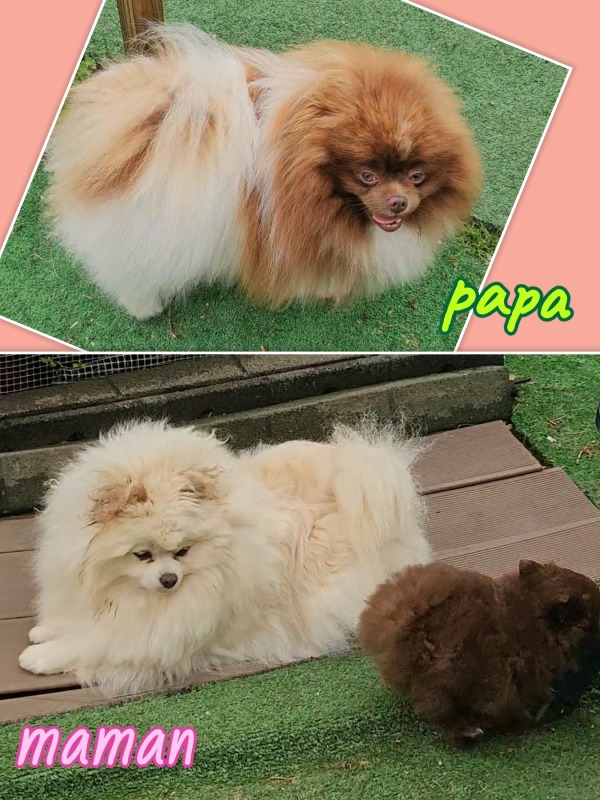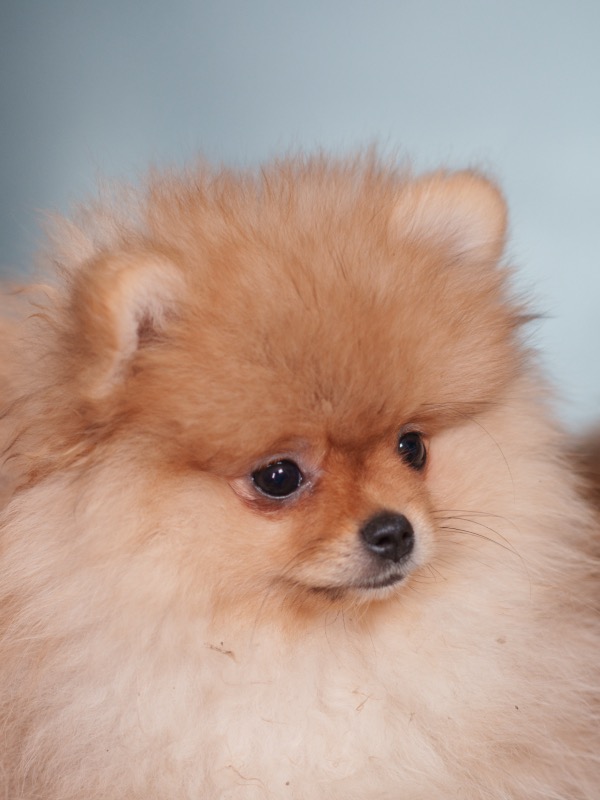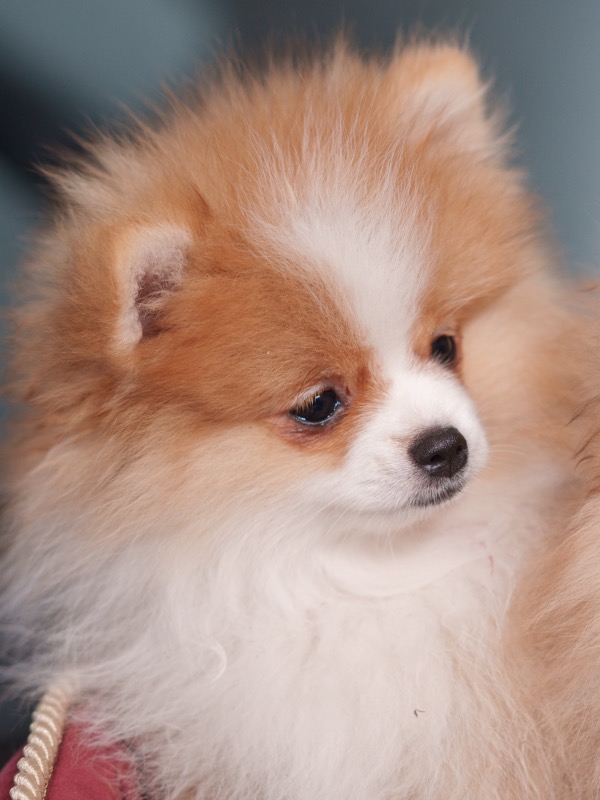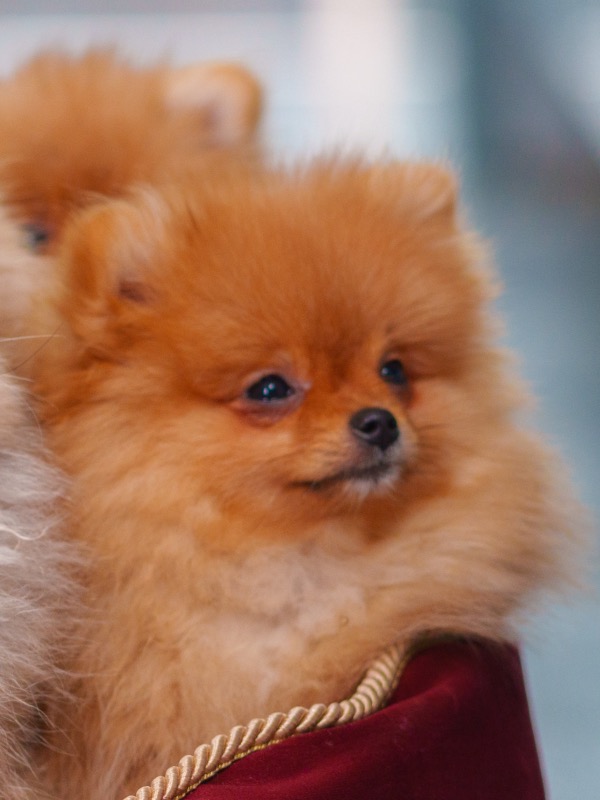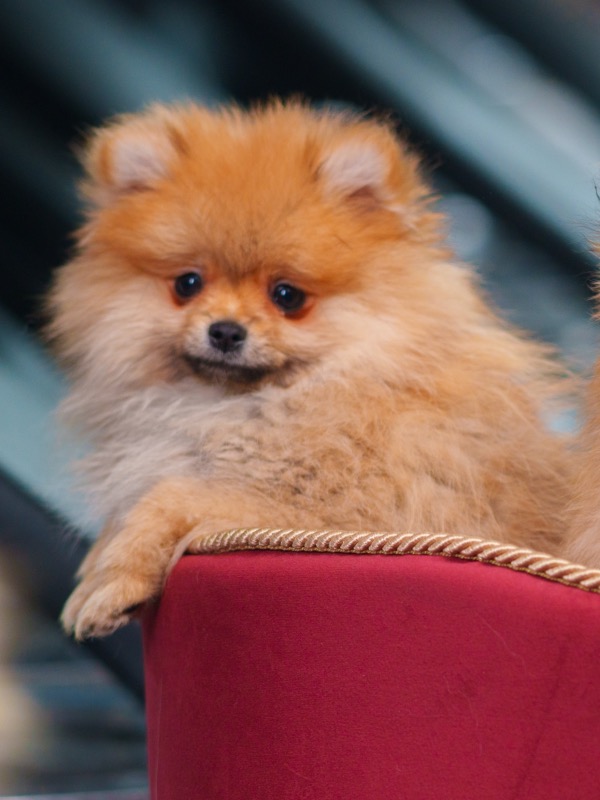Pomeranian spitz
Welcome to our page dedicated to the breed of dog pomeranian spitz!
Here, you will find all the useful information about pomeranian spitz. This descriptive profile will allow you to discover the aspects of this breed. You can notably consult information about the average price, monthly and annual upkeep expenses, their health, name ideas, as well as their official recognition by competent authorities.
Explore this page to discover everything you need to know.
Overall description of the breed
Of German origin, the Pomeranian Dwarf Spitz is the miniature version of the German Spitz. It made its first appearance in the region of Pomerania, located between eastern Germany and Poland, from which it naturally derives its name. Having contributed to the emergence of numerous breeds across Europe, the German Spitz is recognized as a descendant of "peat dogs". However, it wasn't until the early 18th century that the small-sized Spitz made its debut, resulting from a meticulous selection of the smallest subjects, giving rise to the Pomeranian Dwarf Spitz.
This small dog with elegant charm sparked a genuine enthusiasm within the aristocracy and bourgeoisie. Primarily exhibiting a solid black or white coat, it wasn't until the late 19th century that specimens with orange colors emerged. Queen Victoria of England owned a dog of this hue, rapidly elevating this color to trend status within the aristocratic elite.
Throughout history, this plush-like little dog captured the hearts of numerous celebrities. Indeed, Émile Zola, Wolfgang Amadeus Mozart, and even Queen Marie Antoinette (wife of King Louis XIV) became proud owners of a Pomeranian Dwarf Spitz. The German Spitz received official recognition from the FCI on January 1st, 1957. Notably, a recent update of its breed standard was published by the breed club on September 4th, 2019.
Despite its small size, it possesses great robustness. Its body is short and compact, characterized by a well-rounded and relatively broad dome. Its head tapers towards the muzzle and features a pronounced stop that bestows upon it a distinct appearance compared to its larger cousins. Its small ears stand erect on the top of its head, and its semi-circular tail falls along its backline, adding an extra touch to its charm.
Its dense and fluffy coat, particularly thick on the tail and around the ruff, enhances its irresistible allure. Classic coat colors include black, white, cream, and red, but nowadays, other unrecognized shades are also present.
The Pomeranian Spitz is a courageous and naturally cautious small dog. Nonetheless, it excels as a watchdog and won't hesitate to alert its owners in case of danger. Possessing a docile temperament, it is easy to train while providing pleasure throughout the process. Its obedience skills and intelligence are remarkable. Deeply attached to its owners, it often maintains a close bond with them, making it less tolerant of extended absences. Its love for its family is unconditional.
Affectionate and dynamic, it greatly enjoys sports activities and agility courses, always seeking new experiences. In conclusion, regardless of its size, thanks to its loyalty and gentleness, the Pomeranian Dwarf Spitz brings happiness to both small and large individuals.
In adulthood, the Pomeranian Dwarf Spitz will weigh between 2 kg and 3.5 kg (4.5 to 7.5 lb), with a height at the withers of approximately 21 cm (8.2 inches) ± 3 cm (± 1.1 inches).
Awareness of acquiring an animal
Each animal is a sensitive being, deserving love, attention and care.
When you choose to adopt an animal, you take on the responsibility of ensuring its health and well-being throughout its life.
To learn more about animal welfare, we invite you to consult our FAQ by clicking the button below:
Origins
The Pomeranian, also known as the Dwarf Spitz, originates from the historical region of Pomerania, located between present-day Germany and Poland. This breed descends from the large sled dogs of the Spitz, which were used to pull heavy loads in the Arctic and subarctic regions. Over time, selections were made to reduce their size, resulting in the Dwarf Spitz that we know today. These small dogs were appreciated by European royal and noble families, including Queen Victoria of England, who contributed to their popularity in the 19th century. Today, the Pomeranian is one of the most popular small dogs worldwide for its compact size and elegant appearance.
History
The history of the Pomeranian Spitz dates back several centuries, long before it became the adorable companion we know today. Originating from Pomerania, a region in Northern Europe, it descends from larger Spitz-type dogs, mainly used for guarding and working. In the 18th century, the breed gained popularity among European royalty, especially thanks to Queen Victoria of England who owned several and greatly influenced the selection of smaller specimens. This period marked the beginning of the miniaturization of the breed. Over the decades, Pomeranians have been bred to become elegant and affectionate companion dogs, retaining their alert and joyful nature.
Standard
The standard of the Pomeranian Spitz breed is defined by several international canine organizations, including the Fédération Cynologique Internationale (FCI). It states that the Pomeranian should have an elegant and well-proportioned appearance, with a compact body and a tail carried well over the back. The skull is slightly rounded, with dark, almond-shaped eyes, and small, erect ears. The muzzle is fine but well proportioned to the rest of the head. The coat is double, with a dense undercoat and long, straight, and spread out guard hair. Accepted colors are varied, including orange, black, white, blue, cream, and chocolate, among others. The ideal weight varies between 1.8 and 2.5 kg.
Physical characteristics
The Pomeranian Dwarf Spitz is a small dog with a compact and well-proportioned body. It generally measures between 18 and 22 cm at the withers and weighs between 1.8 and 2.5 kg. Its double coat is one of its most distinctive features: the undercoat is dense and soft, while the outer coat is long, straight, and spread out, giving it a fluffy appearance. The coat colors can vary widely, including orange, black, white, blue, cream, sand, chocolate, and combinations of these colors. Its head is proportioned with a fine muzzle, dark almond-shaped eyes, and small erect ears. The tail is fluffy and carried curled over the back, adding to its distinctive look.
Character
The Pomeranian Spitz is known for its lively, joyful, and affectionate nature. Despite its small size, it has a dynamic and courageous personality. This dog is very loyal to its owners and loves to be the center of attention. Intelligent and curious, it is easy to train, although it can sometimes be stubborn. Sociable, it generally gets along well with other animals and loves to play with children, although interactions with younger children should be supervised due to its small size. The Pomeranian is also an excellent guard dog: alert and attentive, it will not hesitate to bark to signal the approach of strangers.
Life expectancy
The Pomeranian Miniature Spitz has a relatively long life expectancy, often ranging from 12 to 16 years, or even more with good care. This longevity is partly due to their small size and natural robustness. However, to maximize their lifespan, it is essential to provide them with a balanced diet, regular veterinary care, and physical activity adapted to their size and energy level. Careful monitoring of their oral health, as well as the prevention of common diseases in small dogs, such as heart or joint problems, also contribute to a long and healthy life for these adorable companions.
Exercise and activity needs
The Pomeranian Spitz, despite its small size, is an energetic dog who needs regular exercise to stay healthy and happy. One or two daily walks totaling 30 to 60 minutes is usually enough to meet its needs. In addition to walks, the Pomeranian enjoys play sessions at home or in a secure garden. Interactive games, such as fetch or dog puzzles, can help stimulate its sharp mind. Although active, it does not require long runs or intense exercise. Moderate physical activity combined with moments of relaxation will suffice to maintain its physical and mental balance.
Recommended diet
The diet of the Pomeranian Miniature Spitz must be adapted to its small size and high energy needs. A high-quality diet, rich in proteins and essential nutrients, is recommended. Small breed kibble is ideal, as it is formulated to meet their specific needs. On average, a Pomeranian consumes between 60 and 100 grams of food per day, divided into two meals. The monthly cost of their food ranges between 20 and 50 euros, depending on the quality of the food chosen. It is also important to monitor their weight and avoid overeating to prevent obesity, which can lead to various health problems.
Training and obedience
Education and training of the Pomeranian Miniature Spitz is essential in developing a well-balanced and obedient companion. Intelligent and receptive, they learn quickly, but can sometimes be stubborn. Socialization from a young age is crucial in helping them get used to various environments, people, and animals. Use positive reinforcement methods, such as rewards and praise, to encourage desired behavior. Consistency and patience are the keys to success. Short but regular training sessions are more effective than long ones. Basic commands like "sit," "come," "heel," and "no" should be prioritized for a good cohabitation.
Behavior with children
The Pomeranian Spitz is generally an excellent companion for children, thanks to its playful and affectionate nature. However, its small size requires some caution when interacting with young children, who may unintentionally hurt it by playing too roughly. It is important to teach children to handle the dog gently and respectfully. The Pomeranian, on the other hand, loves to participate in family games and activities and is often very protective of the little ones. With good socialization and supervised interactions, it can become a wonderful friend for children, bringing joy and energy to the home.
Compatibility with Other Animals
The Pomeranian Spitz Dwarf can harmoniously coexist with other pets, provided that it is well socialized from a young age. Its friendly and curious temperament often makes integration with other dogs and even cats easier. However, due to its small size, it is crucial to monitor interactions with larger animals to avoid accidents. Pomeranians can sometimes exhibit territorial or guard behavior, but this can be mitigated by proper education and positive socialization. In general, with a little time and patience, they can get along with a variety of animals and become a sociable member of the household.
Grooming needs
The Pomeranian Spitz has a double coat that requires regular maintenance to stay healthy and beautiful. Daily brushing is recommended to prevent knots and tangles, as well as reduce shedding. During shedding seasons in spring and autumn, grooming should be intensified. A monthly bath with a gentle dog shampoo helps keep the coat clean and shiny. Ears should be checked and cleaned regularly to prevent infections, and teeth should be brushed frequently to avoid common dental problems in small breeds. Finally, nails should be trimmed regularly to prevent injuries.
Health
The Pomeranian Spitz is generally healthy, but like all breeds, it can be prone to certain health problems. Common conditions include patellar luxation, heart disease, dental issues, and collapsed trachea. Good nutrition, regular exercise, and preventive veterinary care are essential for maintaining their health. Regular visits to the vet can help detect and treat potential health problems quickly. It is also important to ensure their dental hygiene by regularly brushing their teeth. With proper care, these small dogs can live a long and healthy life, often beyond 15 years.
Average price
The price of a Pomeranian Spitz can vary considerably depending on various factors such as lineage, pedigree quality, breeder reputation, and geographical location. On average, the price for a Pomeranian puppy ranges between 1,500 and 3,500 euros. Specimens from champion lines or with exceptional characteristics can cost much more, sometimes up to 6,000 euros or more. It is important to choose a reputable breeder who follows health and animal welfare standards, even if it means paying a higher price. This not only ensures a healthy puppy, but also a loyal companion for many years.
Expenses
Monthly expenses for a Pomeranian Spitz can vary depending on several factors, including food, veterinary care, grooming, and accessories. On average, you can expect to spend between 50 and 100 euros per month. Quality food for small breeds costs around 20 to 50 euros per month. Regular veterinary visits, including vaccinations and parasite treatments, can add 10 to 30 euros per month on average. Professional grooming, if necessary, can cost 30 to 50 euros per session. Finally, buying toys, treats, and other accessories can add 10 to 20 euros per month. These costs may vary depending on the individual needs of the dog and the preferences of the owner.
Name ideas
Choosing a name for your Pomeranian Spitz can be a fun but sometimes tricky task. Here are some suggestions that might suit the personality and appearance of this charming little dog: Pompon, Foxy, Luna, Nino, Bella, Max, Mimi, Charly, Ginger, Coco, Daisy, Rocky, Oliver, Poupette, Simba. When choosing a name, make sure it is easy to pronounce and does not sound too much like basic commands to avoid any confusion during training. Take the time to observe your dog, his character, and his physical characteristics to find the name that suits him best.
Legislation and regulation
The Pomeranian Dwarf Spitz is not part of the dog breeds categorized in France, which means that it is not subject to any specific regulations related to the ownership of so-called "dangerous" dogs. However, as with all dogs, owners must comply with general regulations regarding canine ownership, such as registering the dog with the town hall and keeping it on a leash in public places. Pomeranians must also be identified by microchip or tattoo and be up to date on their vaccinations. It is also advisable to take out liability insurance to cover any potential damages caused by your dog. When traveling abroad, check the specific requirements of the destination country.
Official recognition
The Pomeranian Dwarf Spitz is recognized by several cynological organizations around the world. In France, it is recognized by the Société Centrale Canine (SCC). Internationally, it is recognized by the Fédération Cynologique Internationale (FCI), the American Kennel Club (AKC) in the United States, the Kennel Club (KC) in the United Kingdom, and the Canadian Kennel Club (CKC) in Canada. These organizations define the breed standards and organize dog shows where Pomeranians can be presented and evaluated. Recognition by these organizations also ensures that breeders adhere to health, temperament, and conformation standards, thus contributing to the preservation and improvement of the breed.
Pedigrees
Pomeranian Dwarf Spitz can obtain pedigrees recognized by various breed clubs around the world, ensuring their pure lineage and compliance with breed standards. In France, the Société Centrale Canine (SCC) issues pedigrees. In the United States, the American Kennel Club (AKC) offers pedigrees for Pomeranians. In the United Kingdom, the Kennel Club (KC) also issues pedigrees for this breed. Other clubs include the Canadian Kennel Club (CKC) in Canada, the Fédération Cynologique Internationale (FCI) internationally, and the Deutscher Spitz Club in Germany. These organizations verify the origins of the dogs and certify that they meet the breed criteria, ensuring the quality and purity of the lineages.
Destination and usage
The Pomeranian Spitz is primarily bred as a companion dog, thanks to its affectionate temperament, intelligence, and small size which makes it an excellent choice for apartment living. Due to its alert and vigilant nature, it is also a good watchdog, always ready to alert to the approach of strangers. Although not used for specific working tasks, it excels in canine sports such as agility, rally-obedience, and beauty contests, where its elegant appearance and liveliness are highlighted. The Pomeranian is also often used in animal therapy due to its sociable nature and ability to bring comfort and joy to people in hospitals and retirement homes.
Prohibitions
In France, there are no specific restrictions regarding the ownership of the Pomeranian Spitz, as it is not considered a "dangerous" breed. However, owners must comply with general regulations on dog ownership, including identification, vaccination, and obeying rules of behavior in public places. In some countries, specific regulations may apply, especially concerning international transport where health certificates and up-to-date vaccinations may be required. It is always recommended to check local and national laws regarding dog ownership, especially if you are moving or traveling abroad with your Pomeranian Spitz.
Breeders of Pomeranian spitz
Want to see more breeders of Pomeranian spitz?
Check out the page of our directory listing all breeders of Pomeranian spitzClassified Ads of Pomeranian spitz
Want to see more ads of Pomeranian spitz?
Check out the page listing all the ads of Pomeranian spitzBreed clubs of pomeranian spitz
No of pomeranian spitz breed clubs are currently registered on Preeders.
If you would like to highlight your breed club, sign up for free now and be the first to appear on this page.

